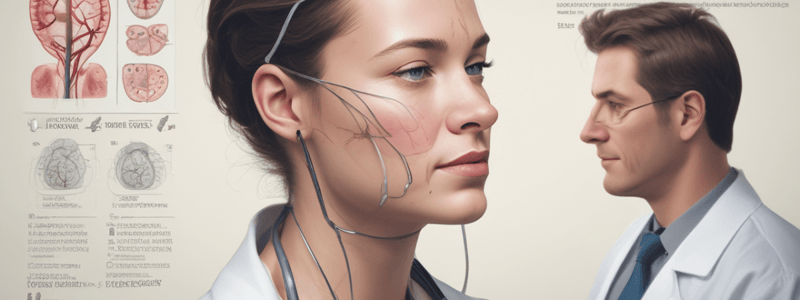Podcast
Questions and Answers
What is the significance of a pertinent positive answer in a patient with a cough?
What is the significance of a pertinent positive answer in a patient with a cough?
- It confirms the diagnosis of TB
- It rules out TB as a cause of the cough
- It prompts the examiner to look for the presence of concomitant symptoms for TB (correct)
- It indicates the presence of dyspnea
What is the significance of a pertinent negative answer in a patient with a cough?
What is the significance of a pertinent negative answer in a patient with a cough?
- It indicates the presence of dyspnea
- It is irrelevant in the assessment of TB
- It confirms the diagnosis of TB
- It helps rule out TB as a cause of the cough (correct)
What is the proposed mechanism of dyspnea according to the Length-Tension Inappropriateness theory?
What is the proposed mechanism of dyspnea according to the Length-Tension Inappropriateness theory?
- Increased respiratory muscle strength
- Stimulation of juxtacapillary receptors by pulmonary blood vessel congestion
- Termination of inspiratory effort by the Hering-Breuer reflex
- A mismatch between the pressure generated by the respiratory muscles and the tidal volume produced (correct)
What triggers the Hering-Breuer reflex in dyspnea?
What triggers the Hering-Breuer reflex in dyspnea?
What factors should be considered in assessing patients with dyspnea?
What factors should be considered in assessing patients with dyspnea?
What type of receptors are stimulated by pulmonary blood vessel congestion in dyspnea?
What type of receptors are stimulated by pulmonary blood vessel congestion in dyspnea?
What is the consequence of the mismatch between the pressure generated by the respiratory muscles and the tidal volume produced in dyspnea?
What is the consequence of the mismatch between the pressure generated by the respiratory muscles and the tidal volume produced in dyspnea?
What is a common breathing pattern adopted by dyspneic patients?
What is a common breathing pattern adopted by dyspneic patients?
What type of retractions may be visible on chest examination in dyspneic patients?
What type of retractions may be visible on chest examination in dyspneic patients?
Which of the following conditions is an example of increased ventilatory demand?
Which of the following conditions is an example of increased ventilatory demand?
What is a common feature of conditions in both groups severe anemia and COPD?
What is a common feature of conditions in both groups severe anemia and COPD?
Which of the following is NOT a cause of dyspnea?
Which of the following is NOT a cause of dyspnea?
What is a consequence of recruiting accessory muscles of breathing in dyspneic patients?
What is a consequence of recruiting accessory muscles of breathing in dyspneic patients?
Which of the following conditions is an example of decreased ventilatory capacity?
Which of the following conditions is an example of decreased ventilatory capacity?
What is a key difference between the conditions in groups 3 and 4?
What is a key difference between the conditions in groups 3 and 4?
Flashcards are hidden until you start studying




